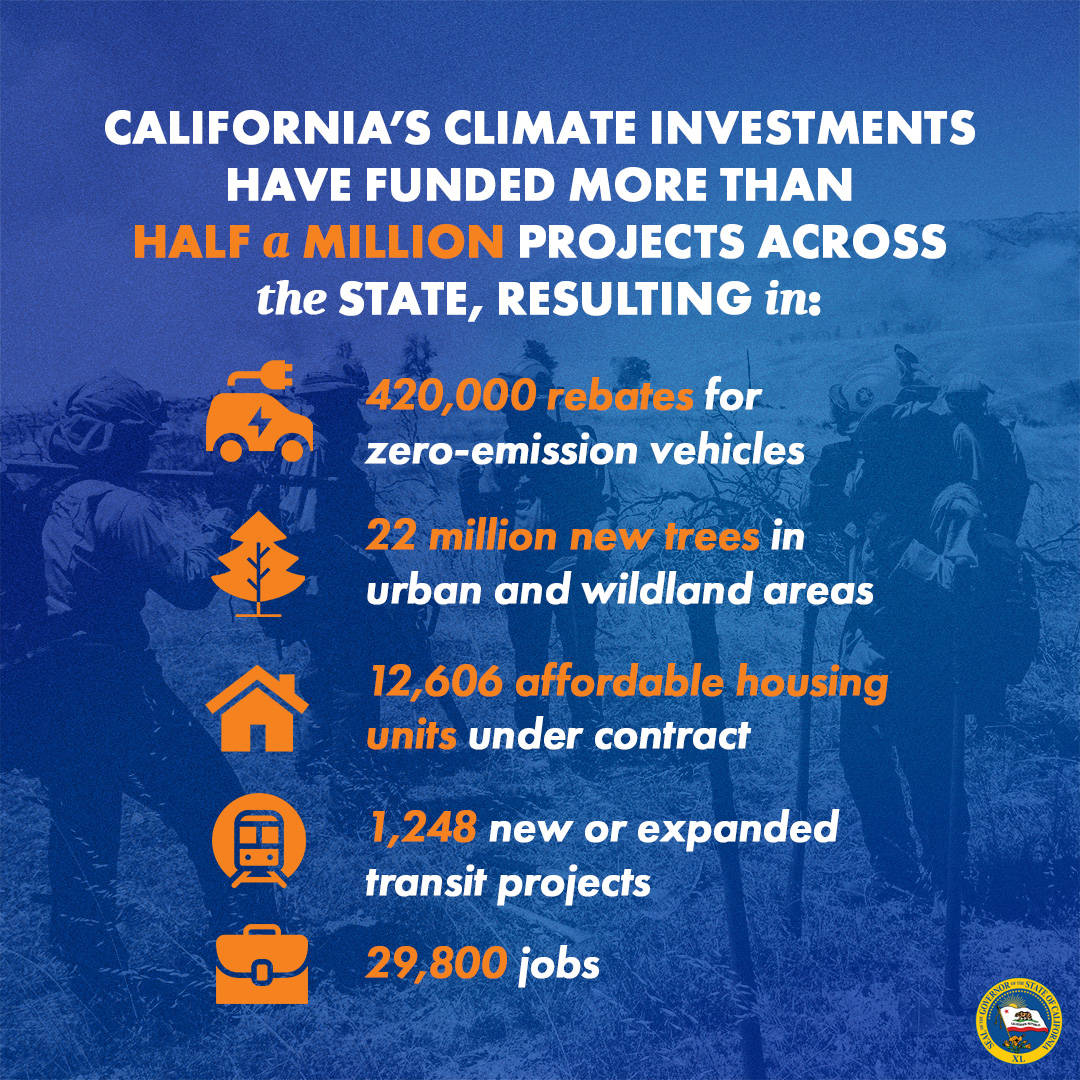California’s cap-and-trade program funds $28 billion in climate investments over last decade
WHAT YOU NEED TO KNOW: California’s cap-and-trade program has funded $28 billion in climate investments – delivering more than half a million projects across the state, supporting 30,000 jobs and cutting millions of tons of carbon emissions.
SACRAMENTO – In just 10 years, California’s climate investments have wiped out emissions equivalent to taking 80% of the state’s gas cars off the road. That’s according to a new report released today by the state, which comes just ahead of national Infrastructure Week.
California has funded $28 billion in climate investments in the last 10 years, already delivering $11 billion to more than half a million projects that fight climate change and cut pollution. The remaining $17 billion will fund more projects in the coming years. The investments include a wide range of solutions such as putting affordable housing near job centers, building the nation’s first high-speed rail, and adding zero-emission transportation options in underserved communities.
The funding comes from the state’s cap-and-trade program, which charges polluters for the carbon emissions they create in the state. The dollars collected then go to the California Climate Investments (CCI) program, which delivers the funds to communities across the state.

About 76% of project funds have been spent in underserved and low-income communities that face the greatest environmental burdens from pollution. CCI projects funded over the last decade have supported 30,000 jobs and are expected to reduce 109 million metric tons of greenhouse gas emissions, which is the equivalent of removing 25 million cars off California’s roads – representing 80% of the state’s total gas-powered cars currently on the roads.
Coupled with Governor Gavin Newsom’s historic California Climate Commitment investments, CCI is an example of California’s world-leading commitment to tackle environmental challenges head on and ensure that the benefits reach those who are often hit first and worst. Working across 24 state agencies, the program supports a diversity of projects that have proven impacts in reducing greenhouse gas emissions to support California’s goals of reaching carbon neutrality by 2045. Find more projects building California’s climate-friendly future at build.ca.gov.
A decade of investments by California’s nation-leading cap-and-trade program shows what’s possible when polluters are forced to pay. 30,000 jobs, 22 million new trees, 12,000 climate-friendly homes, the equivalent of 25 million gas cars taken off the roads – all funded by holding polluters accountable and 76% going to frontline communities.
And this is just the beginning – billions more in investments are on deck that will continue to build the climate projects we need, faster.
Governor Gavin Newsom
Over 10 years, CCI has funded more than half a million projects across the state that have resulted in:
- 420,000 rebates so Californians can get into zero-emissions or plug-in hybrid vehicles
- 22 million new trees in urban and wildland areas
- 12,606 affordable housing units under contract
- 1,248 new or expanded transit projects
- 29,800 jobs
“California Climate Investments is an example of the urgency that the state is placing on solving pressing environmental challenges, backed by $28 billion in funding and guided by a commitment to equity so that no one is left behind as we work toward a healthier future,” said CARB Chair Liane Randolph. “In 10 years, we have accomplished a significant amount of progress in reducing greenhouse gas emissions and California is well on its way to achieve carbon neutrality and clean air.”
Examples of the comprehensive investments that provide emissions reductions, public health benefits and economic growth include:
- Wildfire prevention: CCI has funded CAL FIRE for projects that ease the impacts of climate change by mitigating wildfire. Examples include hazardous fuels reduction to mitigate catastrophic wildfire, forest health and resilience projects that restore degraded forests impacted by wildfire, pests and disease and educating the community about how their actions make a difference in reducing wildfire risk.
- Transit: CCI has provided over $3.5 billion in funding to transit projects through two of the state’s flagship transit programs, the Low Carbon Transit Operations Program and Transit and Intercity Rail Capital Program. The over 1,300 projects across the state funded through these programs are expected to reduce over 30 million metric tons of planet-warming emissions – the equivalent of removing 7.1 million gas powered cars from the road for a year. In 2023 alone, over $500 million supported 181 transit projects.
- High-speed rail: CCI is the only means of ongoing state funding for the California high-speed rail project, all fully invested in disadvantaged communities. Work has begun to extend the 119 miles currently under construction to 171 miles of future electrified high-speed rail from Merced to Bakersfield, creating more than 13,000 construction jobs. Passenger service is expected to begin between 2030 and 2033.
- Sustainable communities: More than $3 billion in funding has been used to create innovative sustainable communities that offer affordable housing and infrastructure near public transportation, jobs, schools and other destinations to cut down on personal vehicle use, the most significant source of greenhouse gas emissions in the state. These investments have resulted in 5.2 million metric tons of greenhouse gas emissions avoided, the equivalent of 37,800 cars removed from the road each year.
- Public health: More 1,650 hospitalizations, 1,000 premature deaths, 168,000 lost workdays and 247,000 Asthma cases in children are expected to be avoided due to reductions in pollutants as a direct result of CCI projects.
In 2023 alone, California Climate Investments implemented nearly 17,000 new projects through $1.7 billion in funding, with 85% of project dollars directly benefiting disadvantaged communities and low-income communities and households. Projects implemented in 2023 are expected to reduce 14.7 million metric tons of greenhouse gas emissions over project lifetimes, with investments in low carbon transit, land conservation and restoration, dairy methane reduction practices, and affordable housing projects driving most of the expected reductions.
